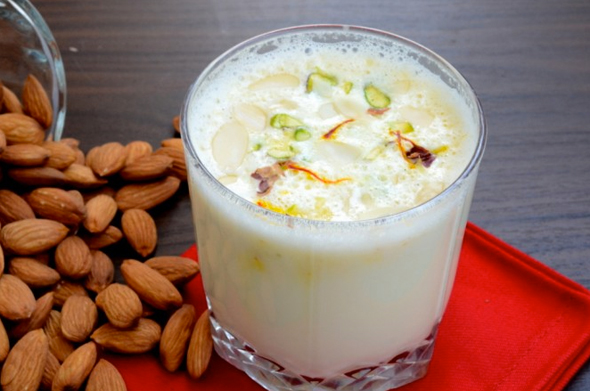Mama’s Punjabi Recipes: Badam Wala Dudh (Hot Almond Milk Tonic)
Saved under Community, Current Stories, Recipe Corner
Tags: Badam Wala Dudh, Baytown, Clear Lake, Cypress, Desi news, Greater Houston, Houston, Houston Desi news, India, Indian American community, Indian News, Indians in America, Indo-American News, Katy, Mama’s Punjabi Recipes, NRI, pearland, Punjabi dishes, Shakuntla Malhotra, south asia, South India, Sugar Land, Texas, USA
With the advent of cold weather, it is the season for sweets, nuts, hot drinks to warm you up and wonderful aromas. Below is a reprint of Mama’s Badam Wala Dudh recipe, which is a filling night time drink that helps you stay warm and sleep soundly during the winter months. It is reprinted with some additional information and directions.
This recipe can’t really be called a dish as it is more of a remedy that can cure flu and cold symptoms. But, it was a drink that my children, nieces and nephews liked so much that they would ask for it during the cold months like a hot sweetened milkshake. It is considered a tonic to help those who have to study hard or do work requiring mental concentration.
But the truth is that this was the tumbler of hot, sweetened milk that we would drink during the frigidly cold months of winter in the western Punjab plains while sitting around the warmth of the chulla (clay hearth) and exchanging gossip about the day’s happenings with the extended family. We grew up by the banks of the River Chenab in the small town of Jhang, Sargodha Division, close to our lands which were farmed by leaseholders. In the winters, our storage rooms would be full of the produce of grains and nuts from the harvests.
This Badam Wala Dudh (hot almond milk) drink has its origins in the farms of West Punjab but was influenced by the far Northwest Frontier provinces where the winters are even harsher and longer. The whole area was – and still is – known for its trade in dried fruits. Our nani (maternal grandmother) would make this hot milk drink with cracked whole almonds roasted in gheyo (clarified butter).
Nani would tell us the hot almond milk would melt the frozen portions of our sinus passages, unclog our heads and free up our lungs by giving us a boost of energy. She would quote a Punjabi folk saying:
Dudh peetheyan budh vadde (Drinking milk increases the brain),
Teh ghee khaade khopadri (and eating ghee the head);
Maas khaade maas vadde (Eating meat expands the fleshy body),
Teh gyuon khadde ohjadri (and eating flour increases the stomach).
These days, people may say it is high in calories due to the gheyo, so you should drink it sparingly in the winters. But it is a great warmer-upper for those really cold winter nights!
Ingredients:
• 2 tbsp ghee (clarified butter)
• 15 badam (almonds), unpeeled
• 1 cup doodh (milk, preferably whole fat)
• 1 tsp chinni (sugar) to taste
Directions:
1. Cover the almonds with a muslin cloth and smash them with a pallet. You can also crush them in a blender, but make sure not to powder them.
2. In a small saucepan, heat the ghee over medium setting, then throw in the crushed almonds and roast them till slightly brown but no more than a minute.
3. Pour in the milk and as the mixture comes to a boil, throw in the sugar and mix.
4. Turn off the heat, pour into a tall cup and sip. You may need a spoon to get the almonds, and also later to scoop them out and eat them.
MAMA’S TIP OF THE WEEK: FOR NATURALLY SWEETENED DESSERT, TRY A FEW KHAJOORS (DATES)
After a meal – and especially if it is a satisfying one – there is the temptation to finish it off with something sweet. Most desserts or cookies are very high in sugar or other sweeteners like high fructose corn syrup and pack a lot of calories. Pastries and chocolates are equally bad for you, especially if you are middle-aged.
A better option is eating two or three dates which are naturally rich in carbohydrates, have a natural sweetener that is not as detrimental for you and the sugar is quickly metabolized. One of the most popular dates are the Medjool variety which contains 66 calories (or 16 gms of sugar) and many other vitamins. Dates also relieve poor digestion, constipation, low metabolism, poor vision and osteoporosis.

Shakuntla Malhotra is a skilled cook of Punjabi dishes made in the old-fashioned style that she learnt as a young woman in her ancestral home in Lyallpur, India (since renamed Faisalabad) before it became part of Pakistan after the Partition in 1947. People have often admired her cooking for its simplicity and taste that comes with each mouthful. Even in her late-eighties, she continues to cook daily and agreed to share her delectable Punjabi vegetarian recipes for future generations.

